ACTIVITY
Water in the Waikato
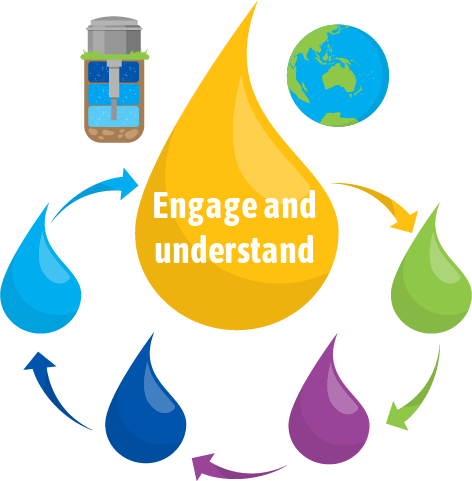
Curriculum links : Levels 3-4
Science: Planet Earth and Beyond: Earth systems.
Nature of Science: Investigating in Science
Activity Idea
In this activity, students explore the major freshwater features and sources of water for the Waikato regions.
By the end of this activity, students should be able to:
- recognise major water bodies in the region
- identify water sources for Waikato.
What you need
- Water in the Waikato - Activity 4 doc Online map, such as NZ Topo Map or Google Maps, to identify water features of interest
- Find the Waikato water features using the maps above
- Sources of drinking water for Hamilton – download as a PDF
- Sources of drinking water for the Waipā district – download as a PDF
- Sources of drinking water for the Waitomo district – download as a PDF
- Finding the water sources
FOR TEACHERS
Introduction
The Waikato River dominates the landscape and provides inspiration for many pūrākau and stories, activities and restoration efforts. Water always runs downhill, from mountains to sea. In the Waikato, freshwater that contributes to the Waikato River starts its journey in the catchment around Lake Taupō. The Waikato River receives water from other sources along the way to Port Waikato – groundwater, precipitation and from smaller tributaries. The Waikato River is a huge source of freshwater for both the Waikato and Auckland regions. The water from the river needs to be treated to make it safe to drink.
These Hub resources provide useful background information about catchments:
Water catchments – general information about catchments using the Waikato River catchment as the context.
Water flows and catchments – a curation of water catchment resources.
Water in the Waikato region – regional Waikato focus.
Water collection
There are a variety of methods used around the Waikato region to collect water from water sources to use for drinking water. In rural areas, people supply their own water through bores, rainwater tanks or springs. In urban areas, there is a town supply, which is provided by the council. The town supply collects water from rivers, streams, springs or bores and transports it to a water treatment plant for cleaning and then distribution.
Water source collection areas in Hamilton City, Waitomo and Waipā districts
For each of the districts, the pipe network receives water from different places and distributes it to our taps.
- Hamilton City Council: 100% comes from the Waikato River collected at Waiora Terrace, Fitzroy.
- Waipā District Council: 62% comes from the Waikato River (from the water treatment plant at Parallel Road), 33% comes from Mangauika Stream, Mount Pirongia (Te Awamutu and Pirongia) and 5% comes from bores from an aquifer (Kihikihi).
- Waitomo District Council: Water sources include Mangaokewa Stream (Te Kuiti), Piopio (surface and underground stream) and Mokau spring.
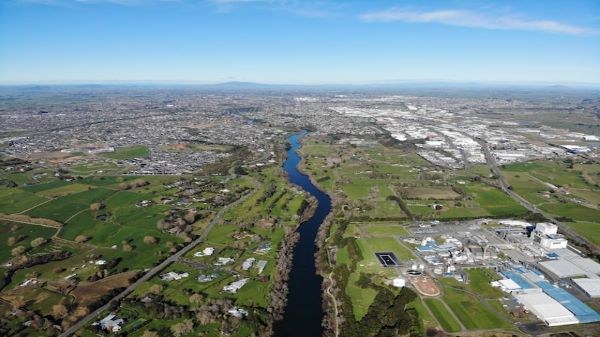
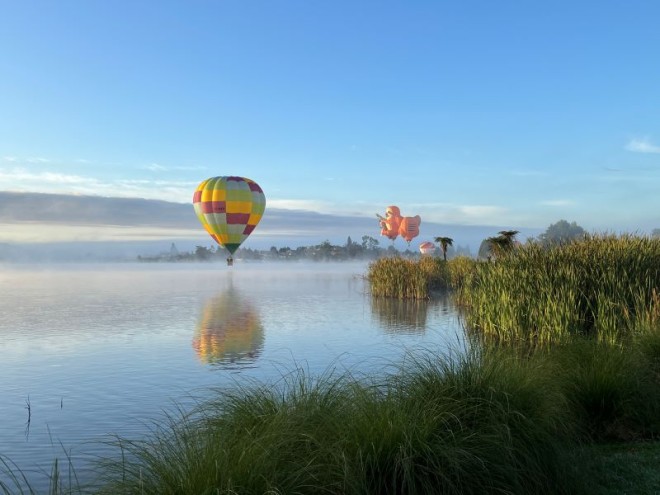
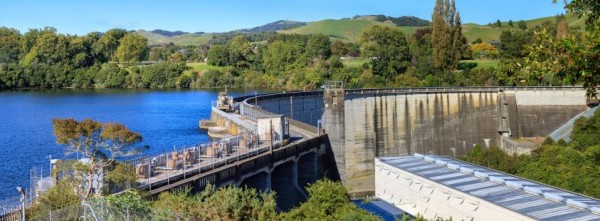
Introducing the features of Waikato
Use online maps such as NZ Topo Map or Google Maps to explore water in the Waikato region. The student handout Find the Waikato water features lists a few of the prominent water features in the region. Ask students to locate each water feature on a map. (The student handout is in Word, so feel free to edit the water features to better meet student needs.)
Discuss local water features that are important in your rohe/local area. Discuss their significance to local residents/hapū and whānau. Record the water feature names, locate these features on a map and note what makes them significant.
Ki uta ki tai
Ki uta ki tai translates as ‘from mountains to the sea.’ In a Māori world view, all water is connected. Water often starts off as pure and clear when it falls as rain but can become polluted or have the mauri altered as it journeys towards the sea.
Describe water’s journey from mountains to sea. How does this relate to freshwater in your area?
Water sources for Waikato drinking water
Discuss where students think their tap water comes from. Water features or water bodies in the region are sources of drinking water. Where your drinking water comes from depends on where you live in the Waikato region. Some areas get their drinking water solely from the Waikato River. Others have bores, streams or springs for supply. Some have a combination of both.
Sources of drinking water
View the PDF poster relevant to your district to find out more about drinking water sources in your district:
- Sources of drinking water for Hamilton – or download as a PDF
- Sources of drinking water for the Waipā district – or download as a PDF
- Sources of drinking water for the Waitomo district – or download as a PDF
Find water sources in your district using the above posters and then complete Finding water sources.
Water mapping in the region
Use one of the following online maps to find out where water travels in your district:
- Hamilton City Council city waters viewer – select water and aerial photo layers on the map.
- Waikato Regional Council water classification map – use the mapping tool to zoom in and find rivers, lakes and water features in your district.
Find the Waikato water features
The following water features are found in the Waikato River catchment. Use an online map such as NZ Topo Map, Google Maps, or a paper map to locate them. Consider water features that are important to your rohe/local area. Write in the names and add description of the water features or explain why they are important to you.
|
Water feature |
Description of the feature |
|---|---|
|
Te Pūaha o Waikato |
The Waikato River meets the sea at this location. |
|
Lake Rotoroa |
This urban lake in Waikato's largest city is a popular place for water sports and recreation. |
|
Waipā River |
This awa joins the Waikato River at Ngāruawāhia. |
|
Waikato River |
This awa is the longest river in Aotearoa New Zealand. |
|
Lake Waikare |
The largest roto in the lower Waikato catchment. |
|
Lake Karapiro |
Formed when a dam was built for a hydroelectric power station. |
|
Te Taheke Hukahuka |
Water from Lake Taupō flows into these scenic falls. |
|
Taupō te moana |
The source of the Waikato River. |
Sources of drinking water for Hamilton
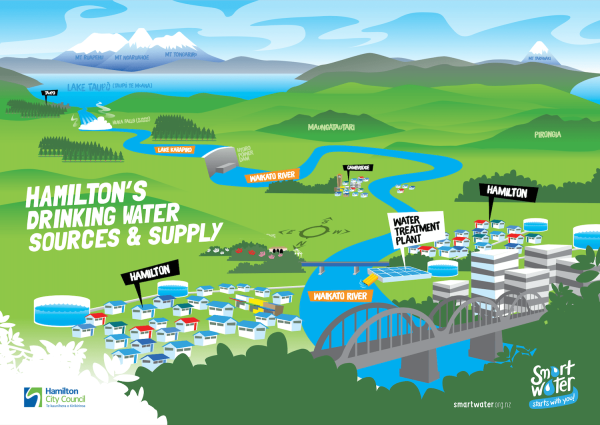
Sources of drinking water for the Waipā district
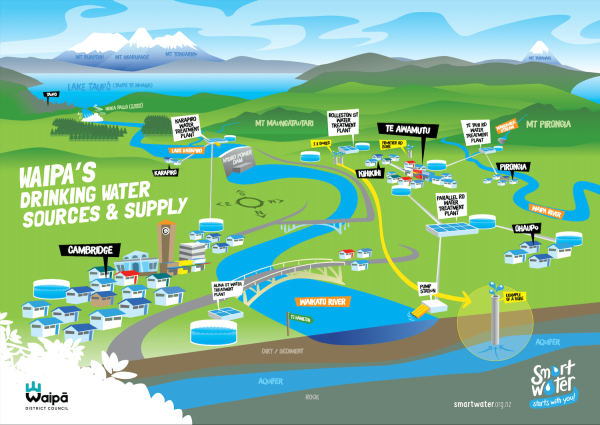
Sources of drinking water in Waitomo district
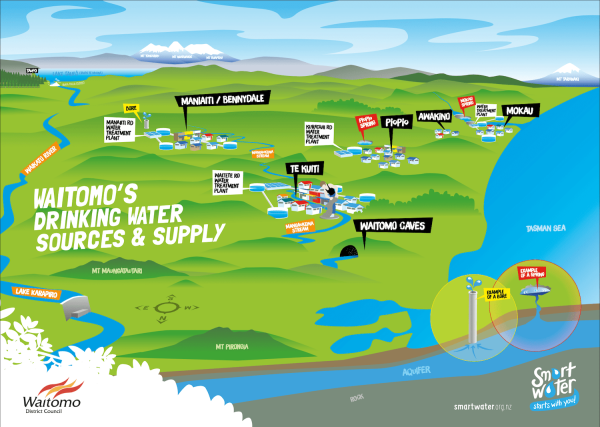
Finding water sources
Find an example of the following water sources in your district’s water source poster.
Use the colour coding to help find an example of each water source.
|
Examples of water sources in Waikato |
|
|---|---|
|
A river |
|
|
A spring |
|
|
A bore |
|
|
Other |
|
Questions for deeper thinking
- How does water move in the landscape?
- Why is it important to keep water bodies such as rivers clean?
Reflecting on learning
- How do students get their drinking water? Are they on a town supply?
- Where is the school’s drinking water sourced from?
Example answers: Finding water sources
Examples of water sources for Hamilton district:
- A river – Waikato River
- A spring – Onewhero, Raglan
- A bore – Te Akau
- Other – Maraetai stream or other
This activity is part of a suite of resources that support Smart Water – a context for learning, which provides students and teachers with opportunities to connect with water and learn more about drinking water in the Waikato region. The science and mātauranga concepts that underpin Smart Water are transferable to other locations in Aotearoa New Zealand. Smart Water is a partnership between Hamilton City Council, Waipā District Council and Waitomo District Council. It aims to foster a greater understanding and appreciation of water from source to tap and supports schools, organisations and communities to use water sustainably.
ADDITIONAL RESOURCES
Activities
Articles
Resources
- Sources of drinking water for Hamilton
- Sources of drinking water for Waipā district
- Sources of drinking water for Waitomo district